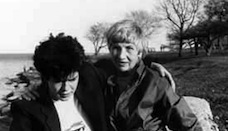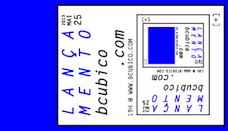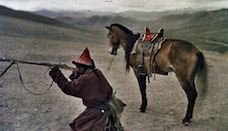mostrar o que não se vê — SU FRIEDRICH & o cinema
À sombra tutelar dos cineastas americanos, trabalhou na área do “documentário subjetivo”; Wharol, Mekas, ou seja artistas que documentaram micro-mundos, ambientes nos quais eles se identificavam, o cinema de Su Friedrich se desenvolveu privilegiando a fala, a escrita de um “eu”, se distanciando da celebração apenas em benefício de um posicionamento em relação ao mundo. Segundo Catherine Russel, mesmo se Warhol transforma seus amigos-atores em produtos, enquanto Mekas torna seus amigos cineastas em poetas de um novo mundo; aquilo que os motivava não era documentar os mundos, mas renovar as formas das representações cinematográficas, colocando em primeiro plano a experimentação formal e a expressão pessoal. Essas duas abordagens serão criticadas pelos cineastas que se afirmaram nos anos oitenta, entre os quais Trinh-Minh-há, Peggy Ahwesh, Su Friedrich, Abigail Child, Leslie Thornton, Pratibha Parmar, Isaac Julien, Marlon Riggs, Richard Fung, são as figuras mais importantes. A primeira vez que eu assisti um filme de Su Friedrich, em Londres, foi Gently Down the Stream de 1981. Esse filme curto me surpreendeu, ele parecia muito distante de tudo que então acontecia na França. Ele associava diferentes técnicas e conteúdos, usados com pouca frequência (poucos usitados) no cinema experimental da época, apesar do fato do cinema do corpo ser um cinema subjetivo, o filme focava mais na performance que na intimidade. Gently Down the Stream coloca a dimensão pessoal como prática política que torna do sonho um instrumento de análise de si mesmo e do social. A política dos corpos e dos gêneros, assim se manifestava através de uma série de sonhos gravada sobre a emulsão. Trata-se de uma seleção do seu diário de sonho. As imagens, acompanhando esses sonhos, não necessariamente ilustravam o conteúdo do sonho, a relação era menos sutil, menos tênue. Como escreve a cineasta, em um livro de artista que ela dedica a esse filme: “Quando a gente assiste ao filme, se leem os treze sonhos”. Os textos espalhados ritmam o filme, dando-lhe um aspecto tátil; eles ritmam e dão forma à imagem composta do filme, palavra por palavra, letra por letra, assinando, legendando, taxando as imagens fotográficas cujo elemento dominante é a água, imagem em movimento constituindo o segundo elemento da proposta. Os sonhos expõem os conflitos pessoais entre a política e a sociedade, frente à sexualidade, religião e feminismo. Esses temas são trabalhados ao longo da obra da cineasta. Quando Su Friedrich se lança, embarca, no cinema experimental, este está amplamente dominado pela produção masculina. Ela constitui o corpus majoritário do panteão da Antologia Film Archive nomeado The Essential Cinema, apesar da importância das obras de artistas norte americanas como as de Maya Deren, Shirley Clarke, Marie...
L A N Ç A M E N T O bcubico.com
Bcubico lança site em fase experimental com apoio do Funcultura —————— concebido pela Editora—Aplicação e estruturado por 3ecologias.net, bcubico.com é a plataforma arquivo voltada para as atividades realizadas pela iniciativa nos últimos dois anos.
Chen Chieh Jen’s movies
Lingchi – Echoes of a Historical Photograph (2002) The concept for Lingchi – Echoes of a Historical Photograph comes from a photograph of lingchi torture taken in China by a French soldier in 1904 or 1905. Historically, there were three victims of lingchi torture who were photographed by different French soldiers. Their images not only served as testimony to savage barbarism in China, but were also made into postcards in Europe and widely circulated among novelty hunters drawn by their foreign, exotic appeal. In his 1961 book Les Larmes d’Éros, Georges Bataille discussed lingchi from a philosophical perspective, making it a widely recognized image among western intellectuals. Also, Bataille’s concern with ecstasy and limit experience made these concepts the most widely cited in discussions about lingchi in the West. With Linchi, Chen Chieh-jen extends his discussion of the history of photographed, which is concealed within the history of photography and is still unwritten. This video also references Bataille’s perspectives on ecstasy in eros to discuss the victim situated within a state of limit experience. Furthermore, Chen uses video technology to enter the body of the torture victim through two large wounds in his chest, where he shows us lingchi-like imagery from the modern history of China and Taiwan. Peering out from these wounds, the camera records portraits of historical western photographers and unemployed laborers in contemporary Taiwan. By way of these successive scenes, the victim’s body becomes a conduit linking the present to the past and serves as a metaphor for the invisible lingchi still present in processes of modernization of the non-western world. Chen believes the victim’s enigmatic smile as he gazes toward the horizon in the historical photograph not only reflects a state of ecstasy induced by opium, but more importantly creates confusion in viewers that begs for an explanation. As the victim endures lingchi, and is completely powerless to take any action or escape, he exhibits a subtle smile which he is able to preserve with the camera in the colonizing soldier’s hand. His smile becomes an act of dynamic defiance through the confusion it generates, and an image that continues to engage viewers in dialog long after the victim’s death. In this way, his smile is an action that cannot be erased by death or time. Using props, hairstyles and costumes that reflect different eras, as well as performances by unemployed workers and actors from small theater groups, the video Lingchi presents the continuing relationship between lingchi imagery and contemporary society. The Route (2006) Made for the 2006 Liverpool Biennial, Chen Chieh-jen’s video The Route is based on the historic Neptune Jade incident and...
Yann Beauvais interview with Anthony McCall
Yann Beauvais: In some of your early films such made after Line Describing a Cone (1973), Conical Solid (1974), (I can’t remember if that was the case with Partial Cone (1974), the rhythm were different; faster, and more using some flickering effects. The crossing and closed rotation of the cross was like a projection of the Maltese cross of the projector. Were you not satisfied with the type of spaces, lines configurations these speeds were conveying? Anthony McCall: The form in “Line Describing a Cone” is defined by a membrane of light that gradually traces the outer surface of the conical form; Conical Solid (1974, 10-minutes), made a year later, attempted to describe the same form, but from the inside. This becomes clear if we recall the final movement, the slowest in the film. A single, flat, triangular blade of light takes five seconds to rotate on its own axis (the axis running from the projector lens to the wall). During that rotation the blade passes through the entire internal space of an imaginary volumetric cone. If the blade of light had left a trace behind itself as it rotated, after five seconds we would have created in three-dimensional space a dense cone of white light—not just the outer surfaces, but the entire form. Hence the title “Conical Solid”. Of course, this cone is never there at any single instant, only incrementally and only in the mind. And the idea I have described gets a thorough workout because the film is composed of eight sequences. Each part rotates at a different speed, starting fast and ending slowly. To achieve the illusion of a smooth rotation, we need a minimum of 36 frames (one and a half seconds). But I begin with a rotation speed that is so fast that we only have four frames to define it. We perceive this as the rapidly pulsing cross you refer to. Gradually, the rotation speed slows down enough that a single rotating form becomes legible, but that isn’t until the last two or three movements. So the film is produced from a collision between the idea of the rotating plane and the limitations of the 24-frames-per-second film strip. The use of the cross in Conical Solid has reappear in later works using double lines configurations, or multi-projection such has in Doubling Back (2003) Between You and I (2006); are these works an extension of long Film for Four Projectors and Four Projected Movements (1974) Although both early and late works are based on membranes of light projected through three-dimensional space, “Doubling Back” (2003) and “Between You and I”...
filmes de viagem ENTRE TURISMO E COLONIALISMO
FILMES DE VIAGEM ENTRE TURISMO E COLONIALISMO Yann Beauvais O uso do cinema é inseparável de outros meios que apareceram ao mesmo tempo do seu nascimento. É que são dois meios de comunicação, ou mais precisamente, duas ferramentas que facilitam o deslocamento, que anulam a distância. O primeiro trabalha as imagens mentais, foi a psicanálise que abriu janelas para acender imagens, dificilmente acessíveis à nossa consciência, quando o outro é o avião que minimizou as distâncias entre lugares e aproxima os espaços. O cinema vai usar este dois paradigmas para elaborar, criar, novos espaços; novos tipos de representações. Se existe uma tradição de literatura de viagem, que se exemplifica nos livros de Joseph Conrad, o cinema vai rapidamente propôr novas alternativas para conquistar e impor novos modos de olhar e pensar o espaço, como as pessoas que vivem nesses espaços. O cinema é inseparável de uma reconquista geográfica do espaço que se ilustra através das múltiplas guerras coloniais que se têm registro, na forma de guerra civil ou de circuito turístico onde o estrangeiro, o exótico, são as manifestações da superioridade do homens branco sobre os nativos do mundo. Os irmãos Lumière vão mandar operadores para filmar e mostrar o que está acontecendo no mundo, evento ligado ao interesse pelo poder econômico e na sua vontade de expansão; se manifesta com a conquista de um novo imaginário que o cinema fornece. Quando o banqueiro e mecenas Albert Kahn decidiu viajar no inicio do século 20, e a partir de 1908, pediu para fotógrafos e cineastas fizessem retratos dos diferente aspectos, das particularidades e modos de vida e atividade humanas da época, . Esses profissionais foram recrutados e enviados pelo mundo inteiro a fim de fotografar em cores e filmar. As fotografias e os filmes constituíram o Arquivo do Planeta. Projeto prefigurando de vários anos, projeto do Getty Museum que hoje, na Califórnia, tentar monopolizar as fontes dessas imagens e representações do mundo. A Fundação Albert Kahn é ainda hoje uma fonte de pesquisa importante para encontrar os primeiros documentos em cores de vários lugares, como por exemplo as primeiras imagens em cores do Rio de Janeiro. As placas fotográficas, placas auto cromáticas, foram desenvolvidas pelo irmãos Lumière que fornecerem as películas para registrar as formas de vida antes que a modernidade acabasse com elas. O projeto participava de uma vontade de preservação (reter os vestígios de um passado que se decompõe em frente a modernidade) e também se inscreve em uma vontade de coleção, no sentido que era possível ver as maneiras de viver dos povos do mundo. De uma certa maneira, o projeto de...



